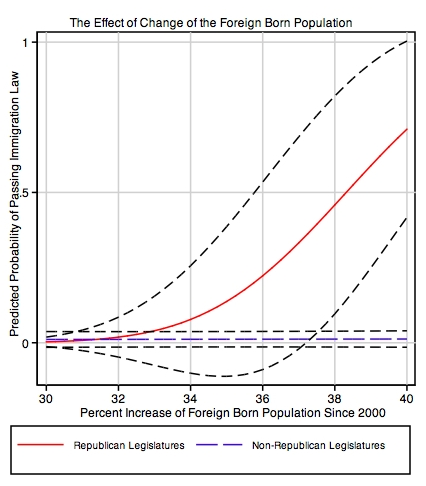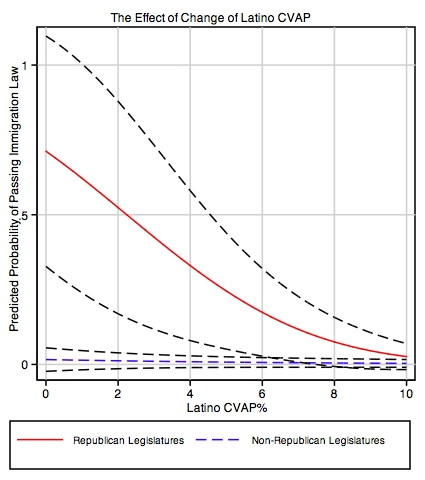Background
With efforts to pass comprehensive immigration reform stalled on the federal level, the states have been playing an increasingly active role in shaping U.S. immigration policy. As a recent Latino Decisions analysis noted, state legislatures have passed hundreds of immigration related bills each year since 2005.
Some of these bills, including SB 1070 in Arizona and HB 56 in Alabama have drawn national headlines. These bills, which were ostensibly geared towards identifying and deporting undocumented migrants as well as denying access to state services, generated considerable controversy as a result of their severity. Challenges to these laws have come in many forms. Many provisions have either been struck down or are currently being challenged in court. The bills have also sparked economic boycotts and, by many accounts (some posted here on Latino Decisions), driven Latino voters away from the Republican Party.
In this sense, it is puzzling that the Republican controlled Arizona legislature decided to pass SB 1070 given the potential electoral ramifications of alienating the state’s sizable Latino population that was recently illustrated by Latino Decisions researchers. Latinos represent roughly 30 percent of Arizona’s total population and a quarter of the citizen population; both numbers are trending sharply upwards. While the bill explicitly targeted non-citizens, SB 1070 was highly unpopular among Latino citizens and non-citizens alike.
The decision to target this rapidly growing group is especially curious given the Republican Party’s experience in neighboring California during the 1990s. The Republican Party, led by then Governor Pete Wilson, supported a series of controversial and racially charged ballot initiatives, most notably Prop 187, which was designed to restrict immigrants’ access to state services. The ballot initiative sparked a substantial increase in Latino mobilization and a backlash against the Republican Party at the ballot box. The legacy of Prop 187 has not been kind to the Republican Party in California; the Republican Party has been unsuccessful at winning back Latinos. As a result, the Democratic Party has come dominate statewide elections in California, which before 1994 was considered a partisan battleground.
In a recent working paper, several coauthors and I demonstrate that Arizona’s Republican Party could face the same long-term problems if Latinos mobilize against the Republican Party as it did in California following Prop 187. The fact that the Arizona Republicans risked alienating Latinos despite the potential electoral consequences raises an interesting question: what is the relationship between the size of the Latino citizen voting age population and the willingness of state legislatures to target immigrant populations with restrictive policies? Does the potential electoral threat posed by a large Latino CVAP diminish the likelihood of policy enactment?
The Determinants of Policies Targeting Undocumented Migrants
I investigate this question in a paper forthcoming in State Politics and Policy Quarterly, where I analyze the determinants of immigration policy enactment. Using the National Council of State Legislature’s immigration policy enactment database, I coded all state immigration policies passed between 2005 and 2011 as either anti-immigrant or pro-immigrant, and then constructed an analysis designed to test what demographic and ideological variables were associated with the passage of these bills.
My basic premise is that a party’s preference for targeting undocumented migrants with restrictive immigration legislation is a function of its ideological disposition—the more conservative the state party the more likely it is to support restrictionist policies. However, the likelihood that a party will actually pass restrictionist immigration policy is conditional upon two other factors: control of the state legislature and the potential electoral ramifications.
Party definitely matters, but what about the potential electoral ramifications? Parties are most likely to enact their preferred policies when the electoral costs are low and the potential benefits are high. The electoral consequences could be significant if Latino citizens mobilize against immigration enforcement polices, meaning the potential electoral threat is highest in places with large Latino CVAPs. The electoral benefits are potentially high in places where citizens are highly aware and potentially threatened by immigrants. Previous studies have demonstrated that the salience of immigration is determined by the relative change in the size of the immigrant population opposed to the absolute size.
The expectation is that states with small populations of Latino citizens that are experiencing a large relative increase in the size of the foreign born population should be the most likely to pass laws targeting immigrants. These are states primarily like Alabama. Alabama has a small Latino CVAP (1.2 percent in 2010) and is experiencing a large relative increase in the size of its foreign born population (between 2000 and 2010 the foreign born population in Alabama increased by 47 percent, compared to 33 percent in Arizona or 24 percent in California).
I conducted a series of multivariate probit analyses in an effort to test these possibilities. I included variables for citizen and party ideology, Latino CVAP, percent foreign born and change in the foreign born percentage since 2000 and a number of institutional and economic controls.
Citizen and legislator ideology are both significant predictors of policy adoption—states are more likely to pass legislation as they become more conservative. Recent inflows of immigrants also make state legislatures significantly more likely to pass bills targeting immigrants. However, the size of a state Latino CVAP% was a negative and statistically significant predictor of policy adoption. These relationships are especially strong if the analysis is limited to only high-profile omnibus immigration bills (such as SB 1070), which are generally the most restrictive. The figures below display the substantive effect of the size of a state’s Latino CVAP and the relative change of the size of the foreign-born population on the likelihood of policy adoption in a given year.
Figure 1: Predicted probability of legislature passing immigration enforcement bill across increased percent foreign-born population since 2000

Figure 2: Predicted probability of legislature passing immigration enforcement bill across increased percentages of Latino CVAP since 2000

Implications
So what do the results of this analysis imply? They imply that Arizona is a notable outlier to the general trend. This analysis revealed a pattern of policy adoption that is somewhat counter-intuitive, it is largely the states with small Latino CVAPs that are passing laws targeting undocumented migrants. Latinos do not represent a large potential voting bloc in Alabama, South Carolina, Georgia, Indiana, or Nebraska, which are all states that passed bills that were very similar to SB 1070. These findings suggests that lawmakers are aware of the potential electoral ramifications of targeting Latinos and other migrant groups and are only willing to do so when they are both ideologically predisposed and the electoral calculus is favorable. The fact that lawmakers were so willing to risk alienating Latinos in Arizona says something about their level of ideological commitment to the legislation—lawmakers in other states have not been willing to incur the same type of risks.
Ultimately, a number of variables shape the likelihood that a state legislature will target immigrant groups with restrictive legislation and the combined effect of these variables produces a more complicated pattern of policy adoption then what might otherwise be expected.
Josh Zingher is a Doctoral Candidate in Political Science at Binghamton University. His research focuses on several aspects of American politics, including mass political behavior, minority and immigrant politics and Congressional elections. He can be reached at [email protected] or www.joshzingher.com.
The commentary of this article reflects the views of the author and do not necessarily reflect the views of Latino Decisions. Latino Decisions and Pacific Market Research, LLC make no representations about the accuracy of the content of the article.


